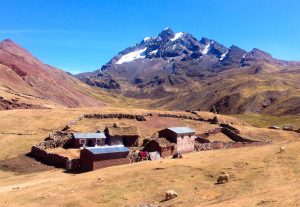
The great mountain Lord (Apu) of Cusco is called Ausangate. On a clear day Ausangate’s north face is visible to Cusco like a massive, shimmering pyramid rising more than 20,000 feet. Every morning Quechua-speakers throughout the region pay their respects to the mountain Lord with a K’intu (An offering of three perfect coca leaves) and incense. They appease the Apu and request his protection for their loved ones, animals and fields. In the past, the great Inca of Cusco also presented offerings to Ausangate on hilltop shrines around the great city praying for the continued flow of energy in the form of sun, water and good crops to ensure a stable empire.
Before I leave the Andes, I decide to visit the Apu. The weather is good and I return to my adopted village of Pitumarka. There is a new road allowing access to the trailhead of the Ausangate nature reserve within two hours. The road was carved through the treacherous canyon to improve the flow of commerce through thin remote region providing access to the furthermost villages. With help, I procure a place on a cargo truck headed up the canyon and Don Timoteo’s nephew accompanies me to make sure I don’t get into mischief. The truck quickly fills with mamachas wearing black polleras (short billowing skirts) and wrapped in woven shawl who prefer to sit on the truck’s bed. They are accompanied by men wearing ponchos and traditional felt hats standing alongside a few llamas, sheep and rough crates filled with chickens and guinea pigs. Tools, and construction materials for structures are also loaded. Despite the pushing and shoving travelers are good natured as we settle in for our journey.

The truck throws up billows of dust as it winds up the Ausangate valley towards the Apu. We encounter villages with simple adobe houses and fields irrigated by canals. As we climb higher the canyon narrows and below us the river turns to rapids. The original Inca road often runs parallel with the new one and is still used by peasants carrying heavy bundles and occasional llama trains. We continue to climb up the canyon and enter different climatic zones exploited for centuries according to their environmental limits. The vegetation changes from terraced fields to native scrub forrest and bromeliad covered cliffs. Llamas, some the size of small horses, are seen grazing along the steep cliffs and on abandoned terraces. Above them soar volcanic pinnacles. At almost every village we stop to unload and allow others to board with their cargo. Smaller roads branch off the main road to the most remote villages where the most marginalized people of South America make a living in the harsh environment.
We reach the trailhead and begin our trek up a river valley leading to the glaciers that cover the south face of Ausangate. We are now in the Puno, the highest, most remote ecological zone in the Andes. The ridges overlooking the river valleys were, until recently, covered with glaciers but are now parched hills of red gravel. Spongey, green moss covers the valley floors more than a meter deep are feed by glacial streams from the surrounding peaks. The Puno is It is inhabited by wildlife, alpaca and the herding communities that watch over them. Along our trek we observe pairs of wayata, the wild Andean goose which prefer to strut around the wildflowers instead of flying away. Dark Andean falcons hover over us inspecting our activities. As we continue up the canyon, Ausangate’s glacier clad peak is clearly visible. It’s enormity is overwhelming and the light reflecting off its glaciers is blinding. We stop to observe its greatness realizing why people have venerated this mountain for centuries. We pay our respects to the Apu by offering a K’intu wondering if it will be accepted by the great Lord.

We ascend a cluster of sun baked hills of red gravel near the remote herding community of Ausangate and encounter my guide’s Auntie. She somehow knows I always carry coca in a traditional woven bag (Chuspa). She tugs on the bag and asks for some. I reach in my bag and give her a generous handful. She continues speaking to me in Quechua, regardless if I can understand or not, inviting us to her house for Wathiya (Potatoes cooked in a earth oven). We accept her invitation and wishes us a safe journey. We descend the deserted hills into another valley occupied by a vast herd of alpaca maintained by Pitumarka for their highly prized wool and meat. We stop near a small adobe house covered with thatch, eat lunch and offer another K’intu to the Apu.

We continue approaching the Apu and within an hour we arrive at a large alpine lake located at the base of Ausangate. The surrounding Puna is covered by a large herd of wooly alpaca peacefully grazing. We watch numerous avalanches cascade down the glaciers then crash thunderously into the lake. A strong wind combined with the intense brightness and heat radiating off the Apu’s icy dome is overwhelming and we look to the sky. Despite a few clouds circling the peak the weather seems to be holding up and we decide to make our ascent.




